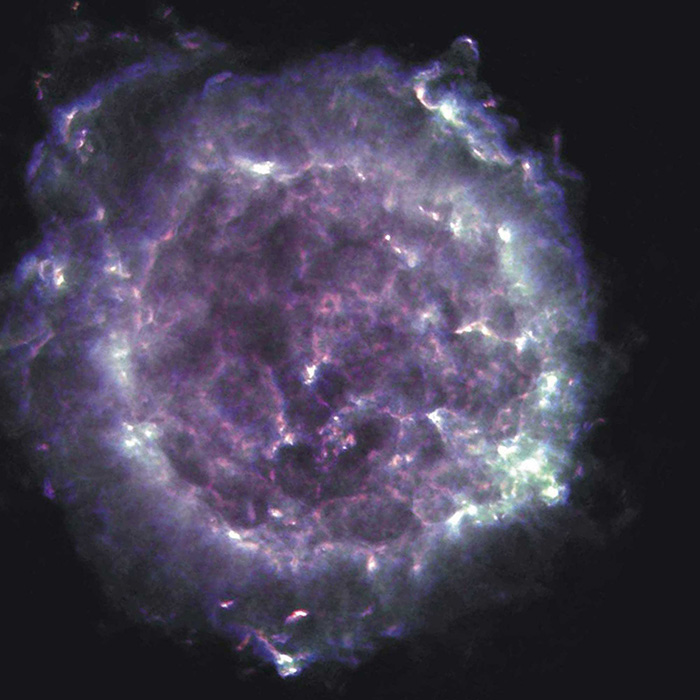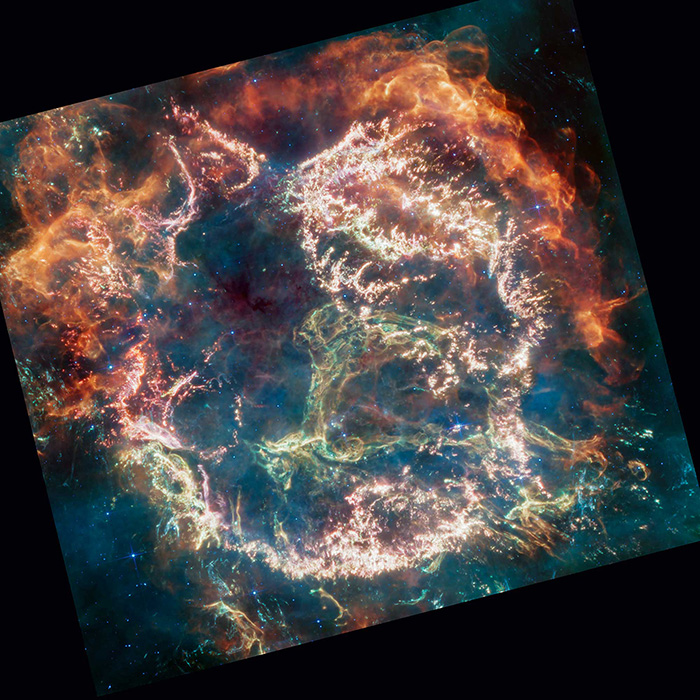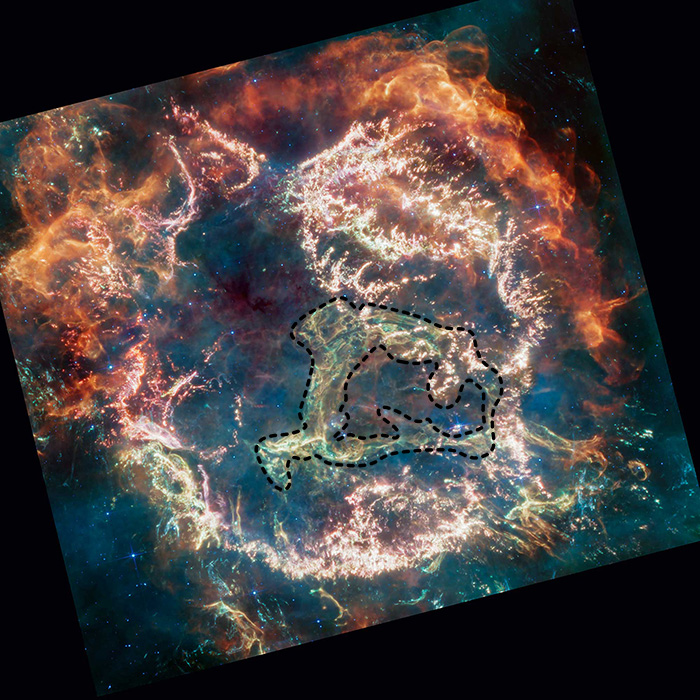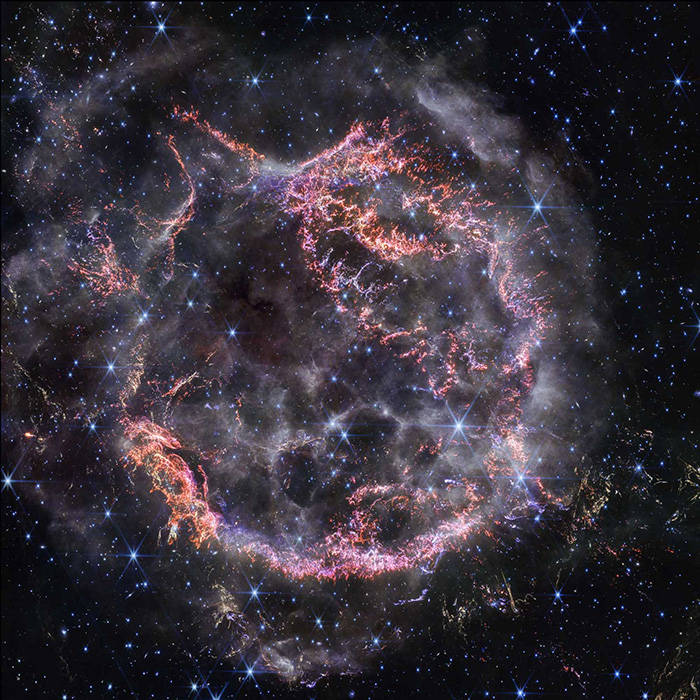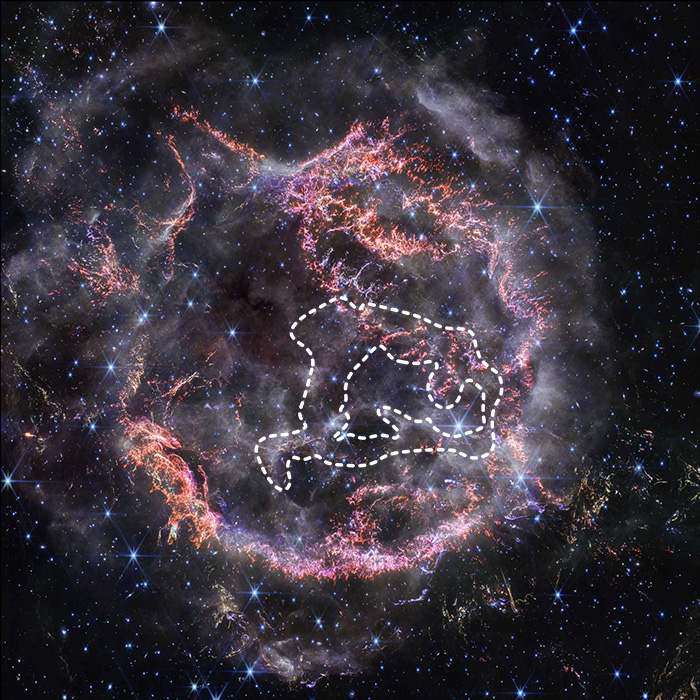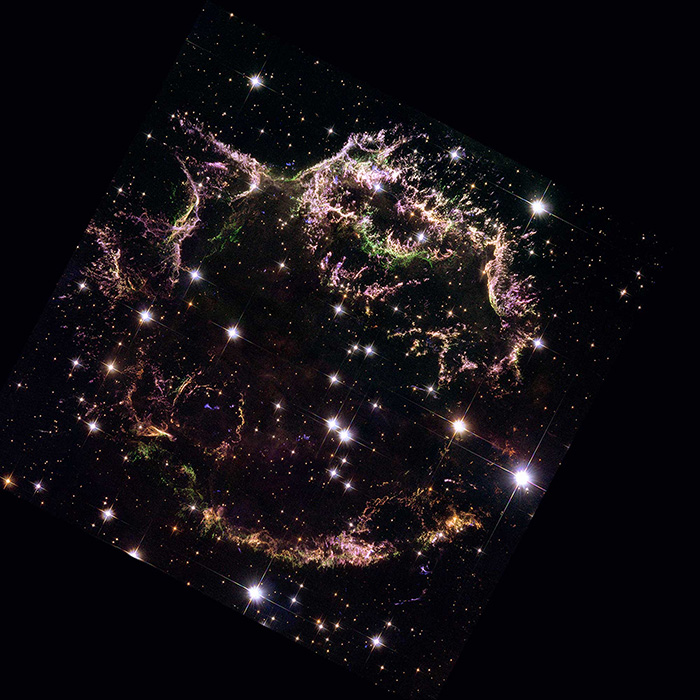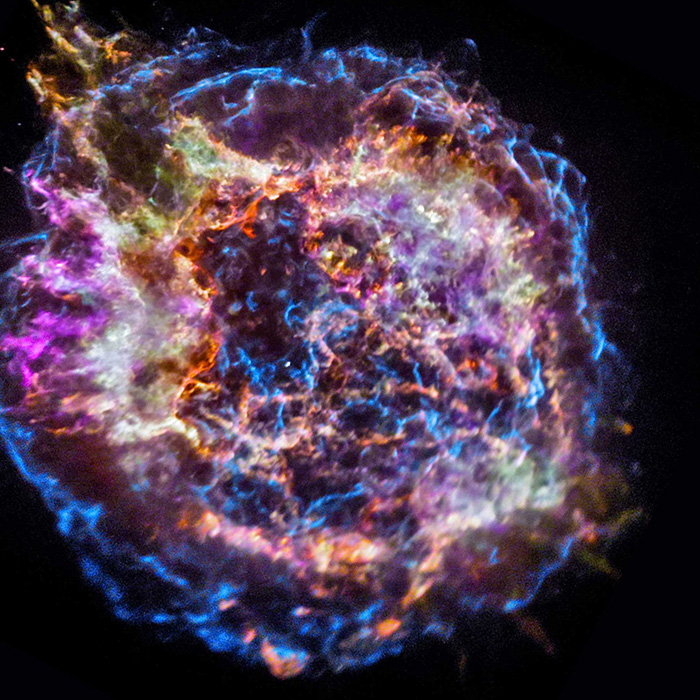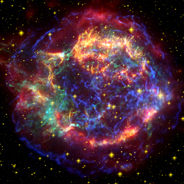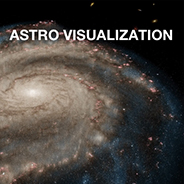Interactive Overview
Slider Interactive: A series of images of the supernova remnant Cassiopeia A seen in different kinds of light. Below the caption is a horizontal slider bar with five labeled stops and a solid white circle. Dragging the white circle right and left along the slider bar causes the image, labels, and caption to change. The change occurs gradually as one image, along with its associated caption and labels, fades out and the next fades in. A toggle button to the upper right of the image turns the image labels off and on. Labels are in the form of text with arrows pointing to specific features in the image. Other labels are graphic overlays.
Slider Stops
From left to right, the slider stops are labeled: Radio, Mid-infrared, Near-infrared, Visible and near-infrared, and X-ray.
Summary of Slider Stops
Sliding left to right reveals the following:
- “Radio” stop shows the supernova as a blurry, circular purple and white cloud.
- “Mid-infrared” stop shows the supernova with an outer, circular shell of orange and red clumpy clouds.
- “Near-infrared” stop shows the supernova with an outer shell of wispy pink and orange filaments. This is the initial image shown when the interactive is loaded.
- “Visible and Near-infrared” stop shows the supernova as a circle of pink and white filaments, resembling paint splatters.
- “X-ray” stop shows the supernova as a circular cloud of blue, purple, orange, and green.
Stop 1: Radio
Image Description: Radio
Cassiopeia A is the circular-shaped cloud of gas and dust in the center. The nebula takes up almost the entirety of the image and lies against the black background of space. The cloud is mostly purple, and the clouds are blurry and mottled. Within the nebula, there is a circle of white clumpy material that traces the inner circumference of the supernova remnant.
Labels: Radio
There are two text labels. A purple and white section in the upper right corner of the circular cloud is labeled “Light from spiraling particles.” The outer edge of the circular cloud is labeled “Expanding shell of gas.”
Caption: Radio
Electrons from the stellar explosion traveling around magnetic lines at almost the speed of light shine in longer wavelengths.
Stop 2: Mid-infrared
Image Description: Mid-infrared
This image reveals the same view of Cassiopeia A, now seen in mid-infrared light. A roughly square image is rotated clockwise about 45 degrees, with solid black corners in the top left, top right, bottom left, and bottom right. Within the image is a circular-shaped nebula with complex structure. On the circle’s exterior, particularly at the top and left of the image, lie curtains of glowing orange material. Interior to this outer shell lies a ring of mottled filaments of bright pink studded with clumps and knots. At center right, a greenish loop extends from the right side of the ring into the central cavity. Translucent wisps of blue, green, and red appear throughout the image.
Labels: Mid-infrared
There are two text labels and one graphic overlay. The red and orange edge of the expanding outer shell in the top right is labeled “Surrounding gas and dust.” At the center of the image, a dashed black line outlines the greenish loop. The loop is labeled “Green monster.”
Caption: Mid-infrared
The supernova blast wave slams into warm surrounding gas and dust, which glows in the mid-infrared, including the “Green monster.”
Stop 3: Near-infrared
Image Description: Near-infrared
This image reveals the same view of Cassiopeia A, now seen in near-infrared light. Similar to the prior “Mid-infrared” stop, the remnant is a circular-shaped cloud of gas and dust with complex structure. The inner shell is made of bright pink and orange filaments studded with clumps and knots that look like tiny pieces of shattered glass. Around the exterior of the inner shell, particularly in the upper right, there are curtains of wispy gas that look like campfire smoke. The white smoke-like material also appears to fill the cavity of the inner shell, featuring structures shaped like large bubbles. Around and within the nebula, there are various stars seen as points of blue and white light. Some have diffraction spikes.
Labels: Near-infrared
There are two text labels and one graphic overlay. A section of the pink and orange outer edges of the supernova is labeled “Knots of gas.” A white dashed line appears at the same location as the outline in the “Mid-infrared” stop. It is labeled “Near-infrared clues of the Green Monster.”
Caption: Near-infrared
Tiny knots of gas from the star itself are visible in the near-infrared and show how the star shattered like glass.
Stop 4: Visible and Near-infrared
Image Description: Visible and Near-infrared
This image reveals the same view of Cassiopeia A, now seen in visible and near-infrared light. Similar to the previous “Mid-infrared” and “Near-infrared” stops, the remnant is a circular-shaped cloud of gas and dust. Filaments that are colored green, red, and blue form a loose, open circle outlining the edges of the supernova. There are stars and galaxies colored red, white, yellow, and green in both the background and foreground. Some of the larger points of light have diffraction spikes.
Labels: Visible and Near-infrared
There are three text labels. Toward the top of the remnant, green filaments are labeled “Oxygen.” A small reddish-purple filament toward the bottom right is labeled “Sulfur.” Toward the bottom left, a section of blue knots of gas is labeled “Hydrogen and nitrogen.”
Caption: Visible and Near-infrared
Elements like those seen in near-infrared and visible light are responsible for life on Earth.
Stop 5: X-ray
Image Description: X-ray
This image reveals the same view of Cassiopeia A, now seen in X-ray light. The nebula takes up almost the entirety of the image and lies against the black background of space. The outer edges of the circle are mostly wispy filaments of bright blue gas. Within the blue outer shell, there are clumps of green, purple, yellow, and orange gas. Striated filaments of bright blue are in the center of the nebula, which surround a tiny white dot.
Labels: X-ray
There are three text labels. The bright blue outermost edge of the circular supernova is labeled “Shock wave hitting ejected gas.” The small white dot at the center of the image is labeled “Neutron star.” Toward the left, a bright purple clump is labeled “Iron.”
Caption: X-ray
Elements in the debris from the exploding star and shocked gas are extremely hot and shine in X-ray light.
